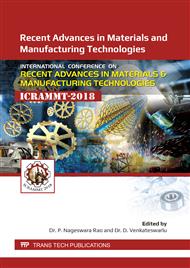[1]
E.A. Voudrias, Pump-and-treat remediation of groundwater contaminated by hazardous waste: can it really be achieved?, Global Nest Journal, 3 (2001) 1-10.
DOI: 10.30955/gnj.000199
Google Scholar
[2]
USEPA, A citizen's guide to pump and treat, Office of solid waste and energy response, Washington, D.C. (EPA 542-F-12-017), 2012a.
Google Scholar
[3]
A.H. Espriú, P.M. Santos, E.S. León and L.E. Marín, Free-product plume distribution and recovery modeling prediction in a diesel-contaminated volcanic aquifer, Physics and Chemistry of the Earth, ELSEVIER, 37 (2012) 43-51.
DOI: 10.1016/j.pce.2010.12.007
Google Scholar
[4]
USEPA, A citizen's guide to soil vapor extraction and air sparging, Office of solid waste and energy response, Washington, D.C. (EPA 542-F-12-018), 2012b.
Google Scholar
[5]
F.I. Khan, T. Husain and R. Hejazi, An overview and analysis of site remediation technologies, Journal of Environmental Management, ELSEVIER, 71 (2004) 95-122.
DOI: 10.1016/j.jenvman.2004.02.003
Google Scholar
[6]
Z. Shi, D. Fan, R.L. Johnson, P.G. Tratnyek, J.T. Nurmi, Y. Wu and K.H. Williams, Methods for characterizing the fate and effects of nano zerovalent iron during groundwater remediation, Journal of Contaminant Hydrology, ELSEVIER, 181 (2015) 17-35.
DOI: 10.1016/j.jconhyd.2015.03.004
Google Scholar
[7]
H.I. Gomes, C.D. Ferreira and A.B. Ribeiro, Electrokinetic Remediation of organochlorines in soil: Enhancement techniques and integration with other remediation technologies, Chemosphere, ELSEVIER, 87 (2012) 1077-1090.
DOI: 10.1016/j.chemosphere.2012.02.037
Google Scholar
[8]
D. Huang, Q. Xu, J. Cheng, X. Lu and H. Zhang, Electrokinetic remediation and its combined technologies for removal of organic pollutants from contaminated soils, International Journal of Electrochemical Science, 7 (2012) 4528-4544.
Google Scholar
[9]
FRTR, Soil Flushing, Remediation technologies screening matrix and reference guide, Washington, D.C., https://frtr.gov/matrix2/section4/4-6.html (2007c).
Google Scholar
[10]
FRTR, Soil Washing, Remediation technologies screening matrix and reference guide, Washington, D.C., https://frtr.gov/matrix2/section4/4-19.html (2007d).
Google Scholar
[11]
FRTR, Bioventing, Remediation technologies screening matrix and reference guide, Washington, D.C., https://frtr.gov/matrix2/section4/4_1.html (2007f).
Google Scholar
[12]
FRTR, Enhanced Bioremediation, Remediation technologies screening matrix and reference guide, Washington, D.C., https://frtr.gov/matrix2/section4/4-31.html (2007g).
Google Scholar
[13]
USEPA, A citizen's guide to bioremediation, Office of solid waste and energy response, Washington, D.C. (EPA 542-F-12-003) 2012e.
Google Scholar
[14]
FRTR, Phytoremediation, Remediation technologies screening matrix and reference guide, Washington, D.C., https://frtr.gov/matrix2/section4/4-3.html (2007h).
Google Scholar
[15]
USEPA, In situ treatment technologies for contaminated soil, Solid waste and energy response, Washington, D.C. (EPA 542/F/06-013), (2006).
Google Scholar
[16]
FRTR, Solidification/Stabilization, Remediation technologies screening matrix and reference guide, Washington, D.C., https://frtr.gov/matrix2/section4/4-8.html (2007m).
Google Scholar
[17]
USEPA, A citizen's guide to incineration, Office of solid waste and energy response, Washington, D.C. (EPA 542-F-12-010), 2012g.
Google Scholar
[18]
USEPA, A citizen's guide to thermal desorption, Office of solid waste and energy response, Washington, D.C. (EPA 542-F-12-020) 2012h.
Google Scholar
[19]
FRTR, Thermal Desorption, Remediation technologies screening matrix and reference guide, Washington, D.C., https://frtr.gov/matrix2/section4/4-26.html (2007o).
Google Scholar


